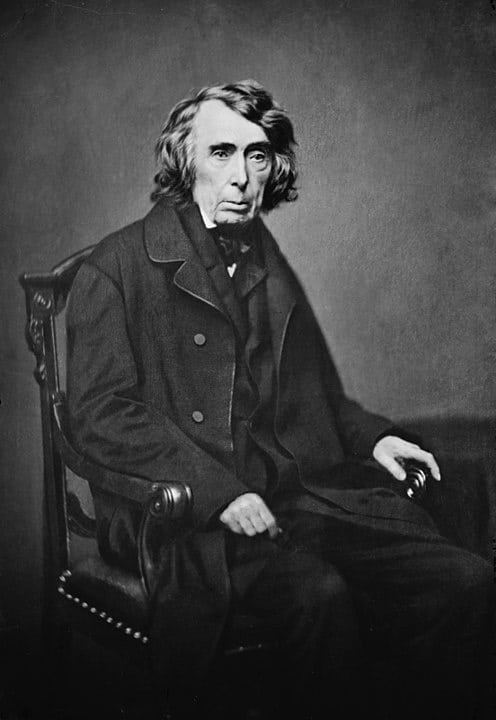Roger B. Taney (1777-1864) was a prominent Democrat (originally a Federalist) from Maryland who attended Dickinson College and read law before being admitted to the bar.
Taney served as a member of the Maryland House of Delegates, in the state senate and as the state’s attorney general. Under President Andrew Jackson, Taney served as secretary of war, attorney general and secretary of the treasury.
As treasury secretary, Taney followed Jackson’s instructions to withdraw federal funds from the second national bank, which Jackson had opposed. (As attorney general, Taney had helped draft Jackson’s bank veto bill.) The U.S. Senate subsequently rejected Taney’s confirmation to the treasury position.
When Supreme Court Chief Justice John Marshall died in 1836, Jackson appointed Taney to succeed him (the Senate had previously rejected Taney’s nomination as an associate justice to replace Associate Justice Gabriel Duvall). Taney was the first Roman Catholic to sit on the U.S. Supreme Court.
Taney relied on Maryland's free expression rights to defend minister
In 1819, Taney, a former slaveholder who had emancipated his own slaves, had in State v. Gruber, successfully defended a Methodist minister against charges of mutiny and rebellion for a sermon that he had delivered condemning slavery. In defending the pastor, Taney largely relied on the rights of expression and conscience in the Maryland constitution rather than the First Amendment. This would have been consistent with the later Marshall Court decision in Barron v. Baltimore (1833) that the provisions in the federal bill of rights, including the First Amendment, applied only to the national government and not to the states.
Taney served as chief justice in years leading up to Civil War
Shortly after Taney became chief justice, he ruled in Charles River Bridge v. Warren Bridge, 36 U.S. 420 (1837) that contracts would be interpreted strictly, which was something of a departure from earlier decisions that gave greater scope to presumed existing property rights. Whereas Marshall had been a strong nationalist, Taney put greater emphasis on states’ rights.
In Luther v. Borden (1849), Taney argued that the decision as to which of two rival state governments qualified as a “republican” government under the U.S. Constitution was a “political question” for the two elected branches to resolve. The Taney Court issued numerous other rulings in cases related to commerce and other matters in which it attempted to divide powers between the state and national governments.
Taney’s most famous decision was Dred Scott slavery case
In Dred Scott v. Sandford, 60 U.S. 393 (1857), Taney’s most notorious case and the one for which he is most frequently remembered, he authored the majority decision that ruled that Scott, a slave, had not become free even though his owner (whose Fifth Amendment property rights Taney stressed) had taken him into a free territory. Indeed, he argued that the Framers of the Constitution had considered Blacks to be inferior, had not intended for them to be included in the egalitarian language of the Declaration of Independence, and that they were not citizens of the United States.
This meant that they would be ineligible to claim the protections of the First Amendment or other provisions of the Bill of Rights. Taney further argued that the Missouri Compromise of 1820, which had excluded slavery from the northwestern territories, had been unconstitutional. This opened the way for the expansion of slavery, which Abraham Lincoln and other Republicans opposed.
President James Buchanan had announced in his inaugural address that the Dred Scott decision would resolve the issue, but that decision, and the subsequent election of Abraham Lincoln in 1860, had the opposite effect, as southern states attempted to withdraw from the Union, and Lincoln fought to retain them. Although Taney administered the presidential oath to Lincoln, the two were often at loggerheads during Taney’s tenure.
During the Civil War, Taney sought to limit Lincoln’s executive powers, especially the power to suspend the writ of habeas corpus. In Ex Parte Vallandigham, 68 U.S. 243 (1863), however, the court ruled that it did not have power to review the judgment of a military court, which had convicted a candidate running for governor of Ohio for inflammatory words questioning the government’s control over civil liberties.
Taney served until his death in 1864 (a total of 28 years) after which President Lincoln appointed Salmon P. Chase to succeed him. The 13th and 14th amendments to the U.S. Constitution subsequently outlawed chattel slavery and declared that all persons born or naturalized within the United States were citizens entitled to the rights of equal protection and due process, thus overturning the Dred Scott Decision.
John R. Vile is a professor of political science and dean of the Honors College at Middle Tennessee State University.

